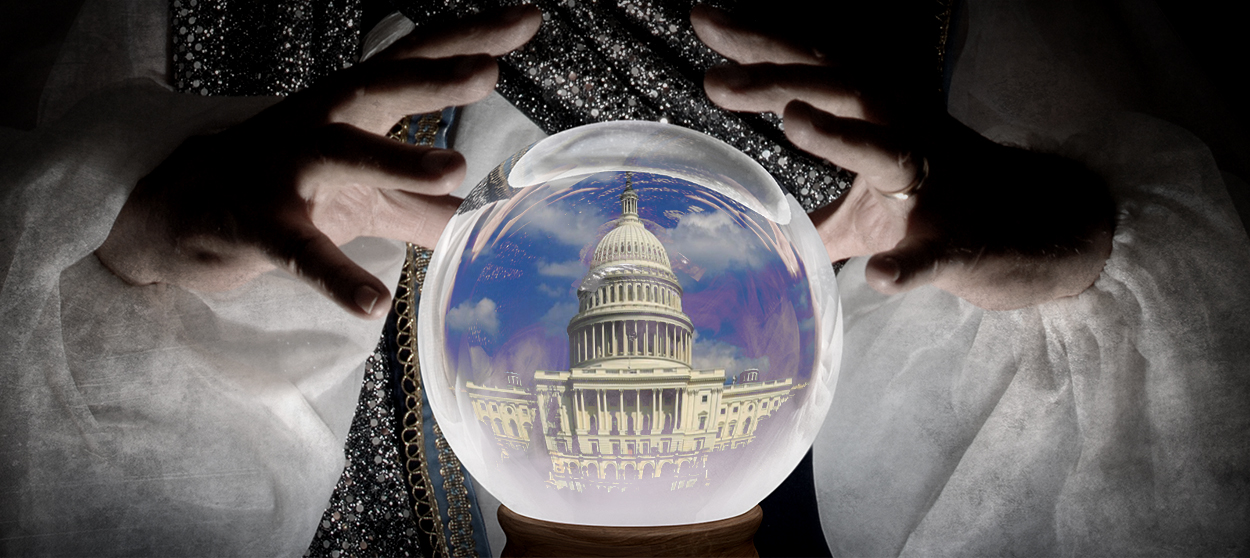What the midterms foretell
What do the 2018 results tell us about 2020 — and beyond?


This has been one hell of a week.
Since polls closed on the midterm elections just 50-something hours ago, Americans have already been whipped through President Trump's freewheeling press conference, the ouster of Jeff Sessions and imperilment of Robert Mueller's investigation, and yet another awful mass shooting. You could be forgiven for losing sight of the historic election we just witnessed.
So: Before we move on to the next scandal du jour, let's try to catalogue what we learned from the midterms, and what they tell us about the future.
The Week
Escape your echo chamber. Get the facts behind the news, plus analysis from multiple perspectives.

Sign up for The Week's Free Newsletters
From our morning news briefing to a weekly Good News Newsletter, get the best of The Week delivered directly to your inbox.
From our morning news briefing to a weekly Good News Newsletter, get the best of The Week delivered directly to your inbox.
1. Suburban voters and women are the key to political victory
This is what 2016 was supposed to look like. The well-to-do women in suburban Virginia, Philadelphia, Atlanta, Phoenix, and elsewhere were supposed to be aghast at the idea of a grotesque pig like Donald Trump occupying the White House. Many such women were indeed aghast, but not enough — or at least not enough college-educated white ones — to save Hillary Clinton.
This time was different.
Democratic gains in the House came in densely populated, educated and diverse enclaves around the country, around major liberal cities like New York and Philadelphia and also red-state population centers like Houston and Oklahoma City. The Republican Party's traditional base in these districts collapsed, with college-educated white voters joining with growing minority communities to repudiate President Trump and his party. [The New York Times]
What was the difference this time? Two years of President Trump in action, for one. Astoundingly competent candidate recruitment by the Democratic Party, for another. But the biggest reason: Hillary wasn't on the ballot! The political world is still overrating Trump's ability to defeat someone not named "Hillary Clinton."
A free daily email with the biggest news stories of the day – and the best features from TheWeek.com
2. The GOP legislative agenda is dead
In January 2017, I heard a member of the Republican congressional leadership make this candid observation: Historically, unified Republican control of the federal government lasts about 18 months; we need to make the most of it. They didn't. And, oh, how they didn't. They passed two major pieces of what I will characterize as ideological or "movement" legislation — the tax cuts and (if we're talking only of the House) an ObamaCare replacement.
The tax cuts were, if anything, a drag on Republican messaging this cycle, and health care was an unmitigated albatross. If we want to zoom out from movement politics, we could include spending on priorities like the military. But if, on the morning after Election Night 2016, Paul Ryan was salivating about systematic reform of entitlements and safety net programs, well … we now know the ending of that movie.
The Republican legislative agenda is dead, dead, dead.
3. The oversight and investigative power of Democrats is alive
Do you know how Trump would've failed to defeat even an unpopular candidate named Hillary Clinton? Picture a political universe in which no one knew about her Emails! Recall how that knowledge entered the political universe — through the machinations of the four-year-long House investigation of the Benghazi attack.
What will Democratic Reps. Elijah Cummings and Adam Schiff uncover over the next 18 months? We have no idea. But given the target-rich environment that is the ethical sewer of the Trump administration, I'd say the smart money is on Many Bad Things.
4. Democrats are repairing the cracks of the vaunted "blue wall"
The GOP won several high-profile races in states like Texas and Florida. It strengthened its grip on rural whites in states where you can rack up a lot of rural white votes — Missouri, Indiana, North Dakota. However, Democrats captured the statehouses of Michigan and Wisconsin. They cruised to easy wins in Pennsylvania.
So picture this: In 2020, the Democratic presidential candidate is not going to have to worry about states like Nevada, Virginia, and Colorado as much as Barack Obama and Hillary Clinton did. They appear comfortably if not cobalt blue. Arizona and Florida remain well within striking distance, if the razor-thin margins of victory in Senate races there are any indication. If the blue wall of the upper Midwest has indeed been fortified, then, at a minimum, the Obama 2012 states, minus Ohio, looks eminently doable for Democrats in '20.
5. We still have no idea what will happen next
Two years is an eternity in politics. We don't know what will happen with the economy. Trump seems to be taking the loss of the House in stride and crowing about gains in the Senate. If he doesn't believe he needs a course correction, he is nuts. An economic downturn would ruin him. If current trends continue, the Trump coalition will continue to die off. The situation doesn't look so dire now, because it is disproportionately represented in the Senate. But he cannot win re-election without his thin ribbon of Rust Belt crossovers. Bigger majorities of whites in Ohio and Missouri cannot help him in 2020.
And despite the ouster of Jeff Sessions, there's always the Mueller Report ...
Scott Galupo is a freelance writer living in Virginia. In addition to The Week, he blogs for U.S. News and reviews live music for The Washington Post. He was formerly a senior contributor to the American Conservative and staff writer for The Washington Times. He was also an aide to Rep. John Boehner. He lives with his wife and two children and writes about politics to support his guitar habit.
-
 11 extra-special holiday gifts for everyone on your list
11 extra-special holiday gifts for everyone on your listThe Week Recommends Jingle their bells with the right present
-
 ‘Furious Minds: The Making of the MAGA New Right’ by Laura K. Field and ‘The Dream Factory: London’s First Playhouse and the Making of William Shakespeare’ by Daniel Swift
‘Furious Minds: The Making of the MAGA New Right’ by Laura K. Field and ‘The Dream Factory: London’s First Playhouse and the Making of William Shakespeare’ by Daniel SwiftFeature An insider’s POV on the GOP and the untold story of Shakespeare’s first theater
-
 How to shop smarter with a grocery budget
How to shop smarter with a grocery budgetThe Explainer No more pushing your cart down the aisles on autopilot
-
 Has Zohran Mamdani shown the Democrats how to win again?
Has Zohran Mamdani shown the Democrats how to win again?Today’s Big Question New York City mayoral election touted as victory for left-wing populists but moderate centrist wins elsewhere present more complex path for Democratic Party
-
 Millions turn out for anti-Trump ‘No Kings’ rallies
Millions turn out for anti-Trump ‘No Kings’ ralliesSpeed Read An estimated 7 million people participated, 2 million more than at the first ‘No Kings’ protest in June
-
 Ghislaine Maxwell: angling for a Trump pardon
Ghislaine Maxwell: angling for a Trump pardonTalking Point Convicted sex trafficker's testimony could shed new light on president's links to Jeffrey Epstein
-
 The last words and final moments of 40 presidents
The last words and final moments of 40 presidentsThe Explainer Some are eloquent quotes worthy of the holders of the highest office in the nation, and others... aren't
-
 The JFK files: the truth at last?
The JFK files: the truth at last?In The Spotlight More than 64,000 previously classified documents relating the 1963 assassination of John F. Kennedy have been released by the Trump administration
-
 'Seriously, not literally': how should the world take Donald Trump?
'Seriously, not literally': how should the world take Donald Trump?Today's big question White House rhetoric and reality look likely to become increasingly blurred
-
 Will Trump's 'madman' strategy pay off?
Will Trump's 'madman' strategy pay off?Today's Big Question Incoming US president likes to seem unpredictable but, this time round, world leaders could be wise to his playbook
-
 Democrats vs. Republicans: who are US billionaires backing?
Democrats vs. Republicans: who are US billionaires backing?The Explainer Younger tech titans join 'boys' club throwing money and support' behind President Trump, while older plutocrats quietly rebuke new administration
